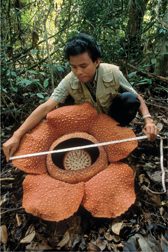Ecological Methods
 What methods are used in ecological studies?
What methods are used in ecological studies?
Some ecologists, like the one in Figure 3–3, use measuring tools to assess changes in plant and wildlife communities. Others use DNA studies to identify bacteria in marsh mud. Still others use data gathered by satellites to track ocean surface temperatures.  Regardless of their tools, modern ecologists use three methods in their work: observation, experimentation, and modeling. Each of these approaches relies on scientific methodology to guide inquiry.
Regardless of their tools, modern ecologists use three methods in their work: observation, experimentation, and modeling. Each of these approaches relies on scientific methodology to guide inquiry.
Observation Observation is often the first step in asking ecological questions. Some observations are simple: Which species live here? How many individuals of each species are there? Other observations are more complex: How does an animal protect its young from predators? These types of questions may form the first step in designing experiments and models.
Experimentation Experiments can be used to test hypotheses. An ecologist may, for example, set up an artificial environment in a laboratory or greenhouse to see how growing plants react to different conditions of temperature, lighting, or carbon dioxide concentration. Other experiments carefully alter conditions in selected parts of natural ecosystems.
Modeling Many ecological events, such as effects of global warming on ecosystems, occur over such long periods of time or over such large distances that they are difficult to study directly. Ecologists make models to help them understand these phenomena. Many ecological models consist of mathematical formulas based on data collected through observation and experimentation. Further observations by ecologists can be used to test predictions based on those models.

Figure 3–3 Ecology Field Work The three fundamental approaches to ecological research involve observing, experimenting, and modeling. This ecologist is measuring a giant Rafflesia flower in Borneo.
3.1 Assessment

-
Review What are the six different major levels of organization, from smallest to largest, that ecologists commonly study?
Apply Concepts Give an example of two objects or activities in your life that are interdependent. Explain your choice.
-
Review Is weather a biotic or abiotic factor?
b. Compare and Contrast How are biotic and abiotic factors related? What is the difference between them?
-
Review Describe the three basic methods of ecological research.
Apply Concepts Give an example of an ecological phenomenon that coold be studied by modeling. Explain why modeling would be useful.
PRACTICE PROBLEMS
Suppose you want to know if the water in a certain stream is safe to orink. Which ecological method(s) would you use in your investigation? Explain your reasoning and outline your procedure.

Table of Contents
- Formulas and Equations
- Applying Formulas and Equations
- Mean, Median, and Mode
- Estimation
- Using Measurements in Calculations
- Effects of Measurement Errors
- Accuracy
- Precision
- Comparing Accuracy and Precision
- Significant Figures
- Calculating With Significant Figures
- Scientific Notation
- Calculating With Scientific Notation
- Dimensional Analysis
- Applying Dimensional Analysis




